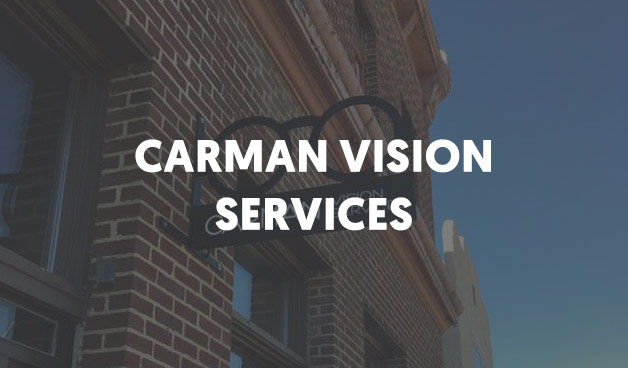Frame Gallery
View some of the fabulous collections we carry in our gallery. We have over 750 frames to choose from, ensuring a perfect look and fit!
 |
 |
 |
 |
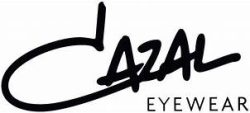 |
 |
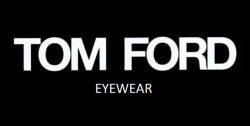 |
|
 |
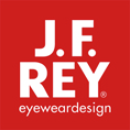 |

Eyeglass Lenses
Eyeglass Lens Designs
Focal Point supplies camera lens quality materials and treatments in a variety of lens designs to suit every lifestyle and budget. Through lifestyle analysis our eyewear consultants can determine the perfect lens for your needs and prescription allowing you to experience optimal vision and function. Ask about the latest breakthrough technology that has revolutionized lens designs improving visual performance. Using proprietary technology, Zeiss’ SmartLife portfolio of lenses are fully personalized to each patient’s prescription, frame wrap, vertex and pantoscopic tilt to deliver the clearest visual acuity. All Zeiss clear lenses feature sunglass-level UV protection.
What’s the difference between Individualized lenses and Off-the-shelf lenses?
DID YOU KNOW…
Single Vision Lenses
Single vision lenses are available in a wide range of products to serve all of our patients needs.
From affordable traditional single vision lenses (Good) to the highest precision with ZEISS Single Vision Individual lenses (Best).
Visual quality, cosmetic appearance and comfort, such as weight, are important factors in the design of single vision lenses. Nowadays, higher refractive indices for both plastic and aspheric surface designs make it possible to produce flat, lightweight lenses, offering patients outstanding visual and wearing comfort, even for those with high prescriptions.
Single vision lenses have only one dioptric power. They are primarily used for single power distance vision or reading.
Spherical Lens Design: Affordable, traditional single vision lenses are the classic product to correct ametropia or to use as single vision reading glasses. This single point focal lens design offers good optical performance for mild prescriptions.
Aspheric/Atoric Lens Design: Thanks to its rotationally symmetrical, aspheric front surface, these traditional single vision lenses display a flatter front curvature and excellent visual quality. They are visibly flatter and thinner than a spherical lens design with the same power, especially in the plus range. Aspheric single vision lenses are recommended for eyeglass wearers with high prescriptions who want cosmetically attractive, lightweight lenses with improved optics.
Widen your view. Beyond aspheric. Beyond standard atoric. ZEISS 3D Single Vision lenses offer improved clarity and vision. Advanced freeform technology allows more precision compared to traditional spherical and aspheric/atoric single vision lenses, leading to clear and sharp vision over the entire lens.
These ZEISS 3D Single Vision lenses are designed for each patient’s full prescription requirements, including sphere, cylinder, axis, and prism. Point-by-point optimization is applied over the entire lens, creating a single vision lens customized to you. ZEISS freeform technology is used to eliminate the visual compromises found in traditional single vision designs.
ZEISS Individual SV embodies the entire, outstanding technological know-how and optical excellence of ZEISS. As a result this lens offers outstanding visual quality for the lens wearer. Absolutely top-class, totally individualized.The combination of the optical expertise of the eye care professional, the professional measurement of all personal data and an optimization process precisely tailored to the needs of each individual wearer results in a level of individualization that will immediately impress the wearer – individualization which is symbolized by the personal engraving on the lens.
ZEISS Individual SV is for all single vision eyeglass lens wearers who want premium optical quality for their eyes.
Individualized for every power
Only optimization for every individual power can ensure that the wearer always enjoys outstanding ranges of vision. This is particularly important for higher cylinder powers and prismatic prescriptions.
“Real time” optimization
To achieve the optimum design for every wearer, each lens design is calculated online by the ZEISS optical design software engine, using the wearer’s exact prescription and his or her individual position-of-wear parameters, immediately prior to fabrication.
Freeform production makes it all possible
Carl Zeiss is a pioneer in the field of freeform technology for progressive lenses. This production method is also used for ZEISS Individual Single Vision in order to transfer the design optimized for each individual power directly and precisely to the surface of the lens.
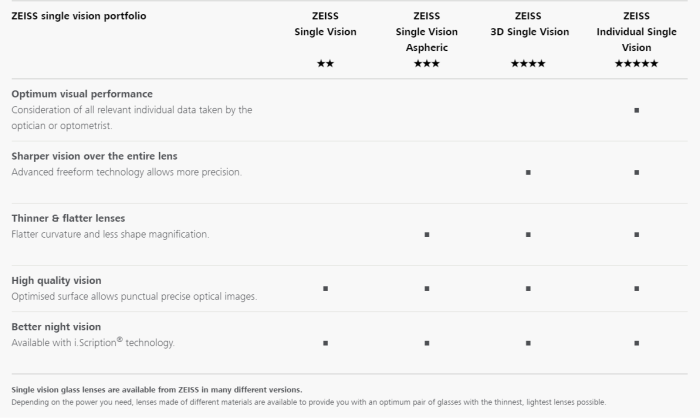
A survey of 10,000 adults revealed that over two-thirds of people in their 20s, 30s and 40s who frequently use digital devices suffer from symptoms related to Digital Eye Strain including tired eyes, blurred vision, neck pain, headache, and/or dry eyes.
Zeiss Digital Lenses: ZEISS Digital Lenses are sharply focused on the use of digital devices, supporting the ciliary muscle’s work in the inner eye, all the while accommodating the dynamic lifestyles of people on the go. These lenses are easy to adapt to and 84% of the population experiencing eye fatigue and are using Digital Device Lenses are satisfied with the results.
Progressive lenses have clear benefits compared to bifocal and trifocal lenses. Progressive lenses have a power for the near, intermediate and distance zones – and all of this in a lens with a seamless transition and no dividing line. The power is smooth from top to bottom and moves from distance to near vision. Progressive lenses enable clear, relaxed vision at all distances and are the perfect choice for correcting myopia, hyperopia and presbyopia. They’re great for reading, working at a computer or with your hands, or for simply gazing into the distance.
Thanks to state-of-the-art production methods with exceptional visual comfort, progressive lenses by ZEISS are precisely fitted to the wearer’s individual needs using a range of factors. Some relevant aspects are the interpupillary distance, the pantoscopic angle and the back vertex distance – to name but a few individual face parameters taken into account during production at ZEISS.
Blurred images in the transition zone or problems climbing stairs – one feature of earlier generations of progressive lenses – are by and large a thing of the past when it comes to progressive lenses. They enable not only clear, natural vision, but also fast focusing at all distances and in all directions. It’s an optimum pair of glasses for everyday use – no matter if this is your first pair, or if you want to switch from reading to progressive lenses, or have only needed distance lenses until now. Progressive lenses are also the ideal solution for people with normal vision who are beginning to develop presbyopia, or for people with astigmatism who are developing presbyopia. Rest assured that no matter what progressive lens category you choose, we ensure that you are getting the best the industry has to offer for your hard-earned dollar.
Good
Quality Back Surface Progressive lenses do away with the limitations of bifocal and multifocal lenses to provide smooth transition from far to near and vice versa and offer comfortable vision.
Unlike traditional conventional progressive lenses, the Premium Back Surface Progressive lens uses the back surface freeform technology. This places the progressive surface on the back of the lenses, providing wearers a wide field of vision.
These entry level progressive lenses allow wearers to see clearer at close quarters with lesser eye movement thanks to Hoya Vision’s back surface freeform technology compared to other back surface designs. It is suitable for a modern lifestyle, where you are always on the move in a fast-paced environment.
Better
ZEISS SmartLife Pure lenses are optimized for conventional and digital reading behaviour that allows a relaxed and natural head and body posture. The design supports fast eye movements from near to far by taking into consideration your connected, on-the-move lifestyle, with wider fields of view than our Good category lenses.
Best
The prescription your doctor writes for you is completely personalized for your eyes. But most progressive lenses are not: they use the same optics for many prescriptions.
ZEISS SmartLife Individual lenses will be designed precisely for your prescription, and manufactured with legendary ZEISS precision for superior performance. You’ll enjoy wide (up to 50% wider), spacious fields of clear vision than ordinary progressive lenses. The SmartLife family of lenses take into account your connected, on-the-move lifestyle, visual behaviour patterns and age-related needs. Never before have progressive addition lenses been so easy to adapt to.
Which progressive lenses are right for me?
Digital Eye Strain affects millions of people every day.
Are you one of them?
Do you use a computer or other digital device more than two hours per day? Do you suffer from dry or tired eyes, head, neck or back pain during these activities? If so, you may be suffering from Digital Eye Strain.
There are eyeglass lenses that can help your eyes stay comfortable at a computer and in many other up-close activities: ZEISS Officelenses are not just for computers. These lenses offer you clearer, more comfortable vision for a variety of other activities like cooking, gardening, gaming, creative handiwork and playing music.
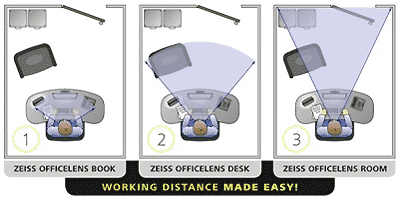
Book:
Ideal for reading, computer use and other up-close activities. These lenses offer the widest fields of clear vision out to approximately 3 feet (100cm).
<strong”>Desk:
Great for reading, computer use and a clear view of a cubicle or small office. These lenses offer wide fields of view to approximately 7 feet (200 cm).
Room:
Appropriate for most indoor activities. These lenses offer clear vision to approximately 14 feet (400 cm).
Most drivers are exposed to difficult driving conditions that impact their vision, including driving in rain, snow or fog, and of course driving at night. For most, this can be a major source of stress – in fact, over two thirds of adults report difficulty driving in these challenging visual conditions. ZEISS DriveSafe, an all-day lens and coating solution designed for patients who need the most help with vision while driving. ZEISS DriveSafe’s unique technology addresses the most stressful visual challenges drivers face today. ZEISS DriveSafe is available in both single vision and progressive lens designs.
Bifocal lenses consist of two lenses, which enable the wearer to see objects clearly both close up and at a distance. This is evident from the dividing line between the two lenses; the lower one is distinctly smaller and looks like a small window. This is the “reading zone” for near vision, and the rest of the lens ensures optimum vision at a distance. The dual prescription gives the lens its name: in Latin, bi means “two” and focal means “focal point.” In the past, bifocal lenses were commonly used to correct presbyopia. These days, they’re not the lens of choice. Many wearers find the clearly visible dividing line unappealing or even irritating, for instance when climbing stairs. What’s the solution? Modern progressive lenses. They offer a seamless transition between the vision zones and thus greater visual comfort.
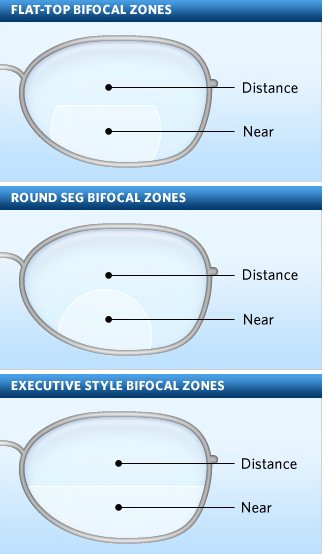
Trifocal lenses (tri means “three”, focal means “focal point”) have a similar structure to bifocal lenses but are used by wearers with presbyopia. In addition to an optimization for near and distance vision, another correction range has been integrated for intermediate distances, i.e. between 50 and 150 cm. Trifocal lenses have the same drawbacks as bifocal lenses: hard transitions between the vision zones and a visible divide between the lenses – both reasons why an increasing number of wearers opt for modern progressive lenses.
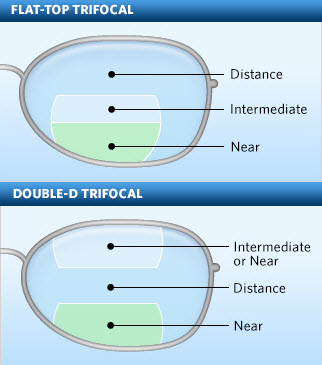
Lens Materials
Eyeglass lenses are available in a variety of materials.
Plastic eyeglass lenses are used today for all types of eyewear, and are also good for sports and children’s glasses. They are very light and therefore comfortable to wear.
They are also highly break resistant. In that respect they outperform glass up to 100 times, depending on the type of plastic used. Moreover, they provide better protection against flying sparks (for example from fireworks, campfires, welding and grinding work) and cannot splinter – a significant safety benefit in many everyday situations. Disadvantage: Compared to natural glass, plastics have a low scratch resistance. As a result, they are more sensitive and require additional maintenance. A special coating can be applied as a remedy, for instance one that repels dirt or hardens the material (such as DuraVision Platinum by Zeiss). Another advantage of plastic: While natural glass can only be tinted in a few colors and at a relatively high cost, plastic eyeglass lenses are easy to treat with virtually all tints. Plastic is the first choice for those who want glasses with colored lenses as a fashion accessory.
Lenses made from natural mineral glass, according to their professional classification – used to be the norm. They still have their place in optometry today thanks to their exceptional scratch resistance, however, they are not widely used with today’s active lifestyles. The advantage of natural glass: It produces considerably weaker color fringes even when the refractive index is identical to that of plastic lenses. The greater the refractive index range (also called the refraction index) of the eyeglass lens material, the thinner the finished glass. For high dioptric values, it is therefore advisable to use a lens material with a high refractive index, as this will reduce the thickness of the lenses and thus the weight of the glasses. For example: A lens with a refraction index of 1.6 is always thinner than one with a refraction index of 1.5 for an identical dioptric value. Natural glass has a clear advantage here: Its refractive index range extends from 1.5 to 1.9, while the refractive index range of organic glass (= plastic) is only 1.5 to 1.74. Natural glass also has a greater density than plastic.
The result: Even when the refraction index is the same, eyeglass lenses made of glass are always thinner than those made of plastic – but they are also substantially heavier and therefore, as stated earlier, not regularly sold in our fast paced, on-the-good lifestyles.
Polycarbonate was developed in the 1970s for aerospace applications and is currently used for the helmet visors of astronauts and for space shuttle windshields.
Eyeglass lenses made of polycarbonate were introduced in the early 1980s in response to a demand for lightweight, impact-resistant lenses.
Since then, polycarbonate lenses have become the standard for safety glasses, sports goggles and children’s eyewear. Because they are less likely to fracture than regular plastic lenses, polycarbonate lenses also are a good choice for rimless eyewear designs where the lenses are attached to the frame components with drill mountings.
Most other plastic lenses are made from a cast molding process, where a liquid plastic material is baked for long periods in lens forms, solidifying the liquid plastic to create a lens. But polycarbonate is a thermoplastic that starts as a solid material in the form of small pellets. In a lens manufacturing process called injection molding, the pellets are heated until they melt. The liquid polycarbonate is then rapidly injected into lens molds, compressed under high pressure and cooled to form a finished lens product in a matter of minutes.
Despite its many advantages, polycarbonate isn’t the only lens material suitable for safety applications and children’s eyewear. Trivex lenses were introduced in 2001 by PPG Industries. Like polycarbonate lenses, lenses made of Trivex are thin, lightweight and much more impact-resistant than regular plastic or glass lenses. Trivex lenses, however, are composed of a urethane-based monomer and are made from a cast molding process similar to how regular plastic lenses are made. This gives Trivex lenses the advantage of crisper optics than injection-molded polycarbonate lenses, according to PPG.
Polycarbonate vs. Trivex lenses
A quick comparison:
- Thickness. Polycarbonate has a higher index of refraction than Trivex (1.58 vs. 1.53), so polycarbonate lenses are about 10 percent thinner than Trivex lenses.
- Weight. Trivex has a lower specific gravity than polycarbonate, making Trivex lenses about 10 percent lighter than polycarbonate lenses.
- Optical clarity (central). Trivex lenses have less internal stress and may produce sharper central vision than polycarbonate lenses.
- Optical clarity (peripheral). Trivex lenses have a higher Abbe value and may produce sharper peripheral vision with less chromatic aberration than polycarbonate lenses.
- Impact resistance. Polycarbonate and Trivex lenses have comparable impact resistance.
- UV protection. Polycarbonate and Trivex lenses both block 100 percent of the sun’s UV rays without the need for special UV-blocking lens treatments.
- Availability. Polycarbonate lenses are available in a wider variety of lens designs (e.g., progressive lenses and other multifocals) than Trivex lenses. Photochromic lenses are available in both materials.
- Cost. The cost of polycarbonate and Trivex lenses can vary considerably, but many optical stores charge more for Trivex lenses than polycarbonate lenses.
Modern light sources and displays emit a disproportionately high amount of blue light. While the human body requires a certain amount of blue light to control the sleep/wake cycle, too much of the ‘wrong’ kind of blue light can pose a health risk and cause eye diseases. Lenses with a blue-light protective material feature a special filter which ensures comfortable vision even when there is a high level of blue light present.
Different lens materials have a different refractive index which dictates how thick the lens would be. The range of the refractive indices of different lens materials ranges from 1.49 to 1.9. The higher this number, the slower the light moves through it. The slower the light moves, the more it bends. The greater the refractive index range of the eyeglass lens material, the thinner the finished lenses.
Lens Treatments
Choosing the right treatments
This treatment provides a harder surface making plastic, polycarbonate and trivex lenses more resistant to normal scratching and everyday use. It is available in varying qualities.
Anti-Reflective treatments effectively reduce eyestrain and eye fatigue while improving the cosmetic appearance of the lenses due to the virtual elimination of light reflections.
An Ultraviolet filter shields your eyes from harmful ultraviolet rays, known as UV. UV protection is widely recommended to reduce risk of ocular diseases like Cataracts and Macular Degeneration.
DID YOU KNOW…
Sunglasses
Sun protection for your eyes should be as natural as protecting your skin. Sunglasses are not only for outdoor protection against long-term eye health complications, but can enhance your outdoor performance with style.
Also known as photochromic lenses, self-tinting lenses have been around since the 1960’s. The small, yet significant discovery made by chemist Stanley Donald Stookey and his colleague, William Armistead, made it possible to have spectacle lenses that react to UV rays remarkably well. Ever since then, a lot has happened in view of the quality and performance of self-tinting lenses and they are extremely popular amongst many people who are dependent on their glasses and constantly going indoors and outdoors.
If you have vision problems, eyeglasses and contact lenses may not always be the most comfortable option, especially when you drive or spend time outdoors. Clear lenses won’t reduce annoying glare and bright light, and contact lenses can feel dry and irritating when it’s windy; or even worse, scratchy and sandy at the beach. Luckily, your corrective prescription doesn’t have to get in the way when you’re lazing next to the pool or hiking in the woods, as prescription sunglasses are available for various lens types to suit your needs. Whether you’re myopic or presbyopic, or you wear progressive, bifocals or varifocal lenses, our eyewear consultants will be able to assist you in customizing sunglass lenses perfectly suited to your prescription. In addition, you can customize prescription sunglasses even further with polarization filters, specialized coatings, mirrors, and solid or gradient tints.Tip: When you’re getting prescription sunglasses, give your eye healthcare professional as much detail as possible. Tell them whether you will be using the sunglasses to drive with, what sports and activities you plan to do, and how often you want to wear them. This will help to give you the best individualized lens solution.
The brightly colored sunglass lenses of the nineties are making a comeback! Customized and prescription sunglasses can be tailored with lens tints in any color you can think of, ranging from bright pink to blue, yellow or green. In addition to being fashionable, tinted lenses can also be useful for sports (read more about that below). Tinted lenses are also available in more conservative hues such as grey or brown, and most colors come in gradient tints – fading from dark into light from the top to the lower half of the lens; or double gradients changing from one color into another. Such sunglasses are particularly comfortable in situations where top and bottom light conditions are different, making them ideal for driving. A lens that is shaded darker towards the top half will enable drivers to see the road clearly, minimizing blinding light, while a lighter gradient hue towards the bottom makes it easier to check instrument panels inside the vehicle. Some colored lenses have limitations, and you can’t necessarily wear them for every occasion. You may have read about, or heard your eye healthcare professional refer to “lens categories”.
These categories differ from lens to lens, and here’s how it works:
| Category | Description |
| 0 ……. | Clear lenses or safety lenses that are not tinted, and are best suited to situations where the wearer needs to see clearly. |
| 1 ……. | Light fashion tints for a unique style that mostly filters low light intensities. |
| 2 ……. | Medium tints to filter medium light intensities. Many sunglasses fall in this category and generally provide full UV protection. |
| 3 ……. | These lenses will block even more visible light than category 2 lenses and are ideal for bright light conditions. Category 3 lenses work well with wrapped frames for sports and water sports. |
| 4 ……. | Category 4 lenses filter 92% or more of visible light. It’s not suitable for driving and is best for specific applications and extreme conditions such as glacier hiking. |
Lens Tip: Not all tinted lenses are suitable for driving, as certain colors may influence your ability to see traffic or signal lights. Colors with light absorption above 25% (category 2 and higher) are not suitable for night driving.
Light reflections create glare, an unpleasant blinding effect often experienced around water, wet surfaces or roads. Glare can be potentially dangerous, especially for drivers and those who do outdoor sports such as cyclists, joggers and skiers. Light waves swing in all directions, but when light is reflected from flat surfaces such as wet roads, for example, the light waves align and swing only in one direction (i.e. it becomes polarized). This effect can be used to eliminate glare. Some sunglass lenses contain polarization filters that don’t allow this reflected (and therefore vertically polarized) light through. Wearing such sunglasses, you will be able to see everything, without the annoying reflections.
Polarized sunglasses don’t only improve visual comfort, but may also improve contrast vision and display colors more vividly, making them suitable for many outdoor activities. Polarization filters are available for most types of prescription sunglasses, so consult your eye healthcare practitioner for more information.
How Do Zeiss Polarizing Lenses Work?
Tip: Polarized lenses are not suitable for all situations. You may struggle to see certain LCD displays or the instrument panels in older cars when wearing them. Be sure to tell your eye healthcare professional exactly what you plan to use your polarized sunglasses for before buying them. Also ask to test the lenses in “real-life” situations rather than only inside a practice or store. Take a walk outside, and look at your vehicle’s panel display through the lenses if possible.
Mirror treatments don’t just look good – they can improve your vision in bright light conditions, and significantly reduce annoying reflections. Mirror coatings can be applied to the front of sunglass lenses, and they’re available in a variety of metallic hues. In addition to being fashionable, mirror coatings limit the amount of light entering the lens even further, so they are ideal for activities that involve very bright light. Premium mirror coatings such as ZEISS DuraVision Mirror also repel dirt, so no more sandy lenses when you’re at the beach!
On-site Edging Lab
It should come as no surprise that the production of eyeglass lenses starts with a visit to one of our optometrists. They will measure your prescription and create a unique vision profile. Then, one of our eyewear consultants will help you select a suitable lens design(s), material and treatments and take measurements to determine how the lenses will be positioned in your favorite frame(s). These are all important factors, and the data must be passed on to the eyeglass lens manufacturer so that they can produce an eyeglass lens individualized and optimized just for you. But what happens next? How does vision analysis result in a modern, customized lens?
First, a semi-finished lens is produced. There are basically two different processes: no matter the manufacturer, individualized precision lenses – also known as prescription lenses – are almost all created using freeform technology. This is a cutting-edge production technique developed by ZEISS that the entire eyeglass lens industry has since licensed.
Unlike prescription lenses, “off-the-shelf” stock lenses are created in a casting process. There is a difference between these two kinds of eyeglass lenses: stock lenses are often selected for a simple, cost-effective pair of glasses, i.e. for child’s glasses, reading glasses or when the wearer needs replacement lenses quickly. Stock lenses are made up at Focal Point’s Morden location. Unlike prescription lenses, these stock lenses are manufactured in large quantities and not individually. Stock lenses are perfectly well-suited for standard vision correction, but do not offer the same level of performance as individualized precision lenses. To produce the latter, the doctor creates a detailed, comprehensive visual profile of the wearer that serves as the foundation for manufacturing the eyeglass lenses.
DID YOU KNOW…
Eyeglasses Care
What is the best way to clean my new lenses?
Maintenance & Warranty
Thank you for choosing quality lenses and frames. All of our eyewear and sunwear are guaranteed against manufacturing defects in materials and workmanship for one year from the date of purchase. Any frame with such defects will either be repaired or replaced at no charge.
Any lenses with such defects will be replaced at no charge. Any lens defects caused by mishap may be replaced, if falling within the extended warranty guidelines for a minimal fee.Manufacturing defects do not include damage caused by abuse or normal wear and tear. This warranty does not include loss, theft or the scratching of lenses (unless due to manufacturing defects).
We provide unlimited complimentary cleaning and adjustment of eyewear purchased at our office. It’s a service we are pleased to provide! The initial fitting of eyewear is essential for successful adaptation to new lenses and frames. This $100.00 value is provided at no charge when you purchase your eyewear at one of Focal Point’s locations.
If after you purchase your eyewear and provide written confirmation of a lower price for the same eyewear (lenses and frame), we will refund the difference. This price match excludes online pricing.
Promotions
Save 25% off additional complete pair of glasses every day!*One pair of glasses often isn’t enough to meet all your on-the-go lifestyle needs. We encourage you to consider task specific glasses for computer, office work, extended reading, hobbies, outdoor activities and other needs outlined in your Vision Care Treatment Plan.*Terms and conditions may apply. Ask your eyewear consultant for more details. Multiple Pair Discount must be redeemed within 3 months of original purchase date and is non-transferrable.
Available for children between 0-13 years of age. Packages start at $89.95 for frame and lenses.
Choose from 5 Options based on your child’s needs
- Clear & Sunglasses
- Clear & Clear
- Self-tinting & Sunglasses
- Clear & Self-tinting
- Self-tinting & Self-tinting
Clear: Clear Trivex lenses with Blue Package Frame
Sunglasses: Polarized (Grey/Brown) tinted lenses with sunglasses or Blue Package Frame.
Self-tinting: Sensity self-tinting lenses (Grey/Brown) with Blue Package Frame.
Packages are also available in high-index material.
Packages are also available in specialty lens designs such as Anti-Fatigue, MiyoSmart and MiSight technology.
Want to upgrade to a Gold Package Frame? No problem. $30.00 for each upgrade.
Save 40% off Plano Sunglasses with ALL First Time Contact Lens Fittings.
Save $50.00 on a complete pair of eyeglasses for first-time new fit wearers with a full-year contact lens package.



